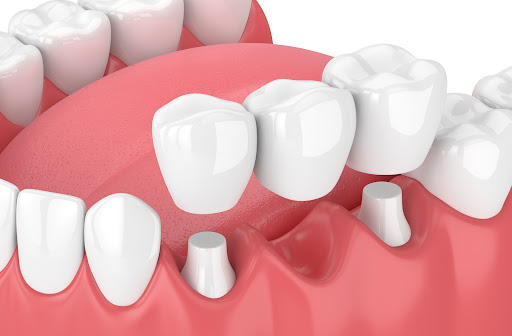What is a Dental Bridge?
If you’re looking to replace a missing tooth or 2, a dental bridge may be the option for you. Dental bridges are sometimes called fixed bridges or fixed dental prostheses. They’re used to replace 1 or more missing teeth. Artificial teeth are placed between 2 crowns attached to the natural teeth, or a dental implant, to keep the artificial teeth fixed in the mouth.
We’ve written you a quick guide to dental bridges and the best way to look after them. If you have further questions and want advice on your individual dental bridge care, contact us. Our team at Shawnessy Dental Centre is always happy to help with your dental concerns.
Types of Dental Bridges
Traditional Bridges
Traditional bridges are used when there are healthy, natural teeth on either side of the bridge. The teeth on either side of the gap are prepared for crowns, and the bridge piece is anchored to your own teeth—a permanent addition to your smile.
Implant-Supported Bridges
An implant-supported bridge is an option if you have a large space in your mouth but no teeth to anchor the bridge to. In this case, dental implants will be placed at either side of the gap, and the bridge will be attached to the implants.
Dental implants involve having a titanium root placed in the jaw. It requires a strong jawbone and healthy gums and may not be an option for everybody.
Resin-Bonded Bridges
Resin-bonded bridges are also called Maryland bridges. This type of bridge is most commonly used to replace missing front teeth. The artificial teeth are placed in the gap and fused to a framework attached to the back of the natural teeth on each side.
Cantilever Bridges
Cantilever bridges are a lot like traditional crowns, with an exception: they’re only anchored to one natural tooth. If there’s a healthy tooth on one side of the missing tooth (or teeth) that can support a crown, this type of bridge may be used.

How To Clean A Dental Bridge
Since dental bridges are permanent additions to the mouth, their care follows quite closely with the care of natural teeth.
Practice Good Oral Hygiene
- Brush twice daily: using a soft-bristled toothbrush, clean your teeth for 2-3 minutes. Make sure you brush all the surfaces of your teeth.
- Floss nightly: Flossing helps remove plaque build-up in hard-to-reach areas of the mouth, like in between the teeth. It helps keep gums healthy, too. Special flossing devices called threaders allow you to floss beneath your dental bridge; a member of your dental care team will show you how to use a threader.
- Use antiseptic mouthwash: antiseptic mouthwash protects the surface of your teeth from a wide range of microbes. Look for a mouthwash with the CDA seal.
Eat a Balanced Diet
Maintaining a healthy diet does the whole body good, and that includes your teeth. Eating too many sugary foods and snacks can have an impact on your oral hygiene. Trying to limit sugars may help manage dental problems.
When you’re searching for a snack, opt for crunchy raw veggies or fruit. These snacks stimulate your gums as you chew, promote the release of saliva, and help keep teeth clean. Dairy products like unsweetened yogurt, cheese, and cottage cheese offer dental benefits with high calcium and protein content.
Another way to help keep your mouth clean between brushing and flossing is to drink plenty of water! Not only does it keep you hydrated, but it also helps rinse the mouth.
Visit Your Dentist Regularly
It’s always important to keep up routine dental visits. Come in for an exam and cleaning! Our professionals will take a look at your bridge to make sure it’s working correctly and the teeth and gums that surround it remain healthy.
The Lifespan of a Dental Bridge
The Canadian Dental Association suggests that bridges may last for around 10 years, though everyone’s experience may vary. Your dentist can judge when your bridge needs replacing, so be sure to come for regular dental exams.
Problems to Watch For
Keeping your dental bridge clean and well cared for is an excellent way to extend its life. When caring for your bridge, there are some problems to keep an eye out for.
If you feel your bridge loosening, the cement used to keep the supports attached to your natural teeth may have eroded. If you notice your bridge is loose, call the dentist right away. The solution may be as simple as re-cementing it.
Another issue that can occur with your bridge is tooth decay or gum disease in the mouth surrounding the bridge. Proper oral hygiene is essential to keeping your bridge working correctly.
Alternatives to Bridges
Bridges are a great dental solution, but there are other options.
Partial dentures are removable dentures often used when the teeth surrounding the gap aren’t strong enough to support crowns. Partials, as they’re called, are held onto your natural teeth by clasps. They can be removed for cleaning, which is often done before sleep .
Space maintainers are often used when children have lost several teeth early and all at once. These appliances make sure there’s enough space in your child’s mouth for their adult teeth to grow in correctly.
Dental implants are another option. They involve implanting a false tooth root made of titanium into the jaw bone through the gums. Dental implants require healthy gums and a strong jaw and may not be a viable choice for everyone.
Fill the Gaps in Your Smile
If you have missing teeth and would like to restore their appearance and function, dental bridges might be what you’re looking for. Visit your dentist to learn more about your dental bridge candidacy and the procedure itself soon!


